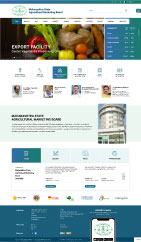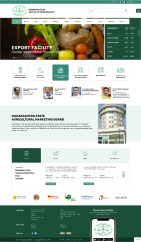प्रकल्प
टर्मिनल मार्केट
- फळे भाजापीला यासारख्या नाशवंत फलोत्पादनाचे 30-40 टक्के काढणीपश्चात नुकसान होत आहे.
- केद्र शासनाने सन 2005-06 साली राष्ट्रीय फलोत्पादन अभियान (NHM) सुरु केलेले आहे.
- या राष्ट्रीय फलोत्पादन अभियानांतर्गत शेतक-याने उत्पादीत केलेल्या नाशवंत फलोत्पादनाचे नुकसना कमी करुन त्यांना जास्तीत जास्त फायदा देण्यासाठी व मध्यस्थांची साखळी कमी करण्यासाठी टर्मिनल मार्केटची संकल्पना पुढे आलेली आहे.
- टर्मिनल मार्केट हे देशातील मोठ्या शहरांजवळ निर्माण करुन असे मार्केटस फलोत्पादन होणा-या भागामधील संकलन केंद्राशी जोडण्याचे नियोजित केलेले आहे.
- अशा संकलन केंद्रांमुळे नाशवंत फलोत्पादन संकलीत करुन त्याठिकाणी क्लिनिंग करुन जास्तीत जास्त गार्बेज त्याच ठिकाणी काढून स्वच्छ केलेला माल टर्मिनल मार्केटमध्ये पाठविण्यात येणार आहे.
- उत्पादित क्षेत्रातील संकलन केंद्र व टर्मिनल मार्केटस् ही रिफर व्हॅन्सने जोडली जाणार असल्यामुळे काढणीपश्चात नुकसान टाळणे शक्य होणार आहे.
- टर्मिनल मार्केटमध्ये आलेले फलोत्पादन प्रिकुलिंग व ग्रेडींग करुन कोल्ड स्टोरेजमध्ये साठवणूक करण्याचे नियोजित आहे.
- टर्मिनल मार्केट मध्ये इलेक्ट्रॉनिक लिलावगृहाद्वारे मालाची विक्री होणार आहे. तसेच सदर मार्केटमधून देशांतर्गत विक्री व्यवस्था, फलोत्पादनाच्या प्रक्रियेची व्यवस्था अपेक्षित आहे.
- टर्मिनल मार्केटमधून फलोत्पादन निर्यातीस पाठविणेही अपेक्षित आहे.
- यासाठी टर्मिनल मार्केटमध्ये प्रशितकरण, शितगॉह, रायपनिंग चेंबर, ग्रेडींग पॅकींग, गोडावून, प्रक्रिया केंद्र , बँक, पोस्ट ऑफिस, इलेक्ट्रॉनिक लिलावगृह इ. मूलभूत सुविधा निर्माण करणे अपेक्षित आहे.
- टर्मिनल मार्केटची उभारणी सार्वजनिक व खाजगी क्षेत्राच्या सहभागातून (Public-Private-Partnership) अपेक्षित आहे.
- टर्मिनल मार्केट हे हब (Hub) व स्पोक (Speak) संकल्पनेवर आधारित चालविण्यात येणार आहे.
- टर्मिनल मार्केटमध्ये 70 टक्के फळे व भाजीपाला, 15 टक्के अन्नधान्य व 15 टक्के पोल्ट्री, मांस, दुग्धजन्य पदार्थांची हाताळणी अपेक्षित आहे
टर्मिनल मार्केट संकल्पनेचा उद्देश
- फलोत्पादनाच्या विक्रीचे प्रचलित पध्दतीमुळे होणारे नुकसान कमी करणे.
- शेतक-यांना थेट बाजारांशी संपर्क प्रस्थापित करुन उत्पादनाच्या विक्रीस पर्याय उपलब्ध करुन देणे व मध्यस्थांची साखळी कमी करणे.
- फलोत्पादन पणन व्यवस्थेत आधुनिक साधनांचा उपयोग करणे व खाजगी गुंतवणूकदारांच्या सहाय्याने शीत साखळी निर्माण करणे.
- फलोत्पादन खरेदी- विक्रीच्या व्यवहारात पारदर्शकता आणणे.
- फलोत्पादन निर्यातीस प्रोत्साहन
- फलोत्पादन प्रक्रियेचे प्रमाण वाढविणे.
- टर्मिनल मार्केटची उभारणी
- स्पर्धात्मक निविदांद्वारे निवड केलेल्या खाजगी उद्योजकांकडून टर्मिनल मार्केटची उभारणी BOO (Build Own Operate) पध्दतीने अपेक्षित आहे.
- खाजगी उद्योजकांमध्ये व्यक्तिगत उद्योग, शेतकरी उत्पादक, ग्राहकांचा समूह, पार्टनरशीप, प्रोपरायटर फर्म, कंपनी, कृषि पणन मंडळ, कॉर्पोरेशन, सहकारी संस्था इ. चा समावेश आहे.
केंद्र शासनाचा सहभाग
- केंद्र शासनाच्या मार्गदर्शक सुचनांनुसार खाजगी भागीदारास 25 ते 40 टक्के (जास्तीत जास्त रु. 50 कोटी) अनुदान मागणी करता येते अशी तरतुद आहे.
राज्य शासनाची भुमिका
- टर्मिनल मार्केटसाठी जागा निश्चित करणे, शासकीय जागा उपलब्ध करुन देणे.
- खाजगी गुंतवणुकदारास आकर्षित करण्यासाठी वित्तीय संस्थांची निवड करणे, शक्य असलेल्या सर्व प्रकारच्या परवानग्या देणे.
- आवश्यकतेप्रमाणे प्रकल्पात आर्थिक सहभाग घेणे.
- टर्मिनल मार्केट संदर्भात निविदा प्रक्रिया व खाजगी उद्योगांची निवड करण्यासाठी मा. पणन मंत्री यांच्या अध्यक्षतेखाली राज्यस्तरीय समितीची स्थापना झालेली आहे. मा.प्रधान सचिव, सहकार व पणन यांची नोडल ऑफिसर व मा.पणन संचालक यांची अतिरिक्त नोडल ऑफिसर म्हणून नियुक्ती केलेली आहे.
- राज्यात उभारण्यात येणा-या टर्मिनल मार्केटकरिता राज्य स्तरीय समितीने खालीलप्रमाणे संस्थांची वित्तीय संस्था म्हणून नियुक्ती केली आहे.
टर्मिनल मार्केट सद्यस्थिती
- केंद्र शासनाने विविध राज्यात प्रथम 8 व नंतर 21 टर्मिनल मार्केटस उभारण्याचा निर्णय घेतला.
- राज्यामध्ये मुंबई, नाशिक व नागपूर येथे टर्मिनल मार्केट उभारण्यात येणार आहेत.
मुंबई टर्मिनल मार्केट
- प्रकल्पाची अंदाजित किंमत रु.200-250 कोटी.
- प्रकल्पाची प्रति दिन हाताळणी क्षमता 3000 मे.टन इतकी अपेक्षित.
- प्रकल्पास आवश्यक जागा 125 एकर आहे. मौजे बाबगाव, जि.ठाणे येथील 92 एकर जागा पणन मंडळास हस्तांतर करणेचा शासन निर्णय झालेला आहे.
- सदर जागा महाराष्ट्र राज्य कृषि पणन मंडळाच्या ताब्यात घेण्याची कार्यवाही सुरु आहे.
- 92 एकर जागा ताब्यात घेण्याची प्रक्रिया प्रगतीपथावर आहे.
नाशिक टर्मिनल मार्केट
- प्रकल्पाची अंदाजित किंमत रु.60 कोटी.
- प्रकल्पास आवश्यक जागा 100 एकर
- प्रकल्पाची प्रति दिन हाताळणी क्षमता 1000 मे.टन इतकी अपेक्षित.
- प्रकल्पाकरीता पिंप्री सय्यद येथील शासकीय जागा हस्तांतरणाची प्रक्रिया सुरु आहे
नागपूर टर्मिनल मार्केट
- प्रकल्पाची अंदाजित किंमत रु.70 कोटी.
- प्रकल्पाची प्रति दिन हाताळणी क्षमता 750 मे.टन इतकी अपेक्षित.
- 100 एकर जागेची आवश्यकता आहे.
- प्रकल्पास मौजे काळडोंगरी ता.जि. नागपुर येथील आवश्यक 100 एकर शासकीय जागा पणन मंडळास हस्तांतर करणेचा निर्णय झाला. जागा हस्तांतर करणेची प्रक्रिया सुरु.
- जागा ताब्यात घेण्याची प्रक्रिया सुरु आहे.



